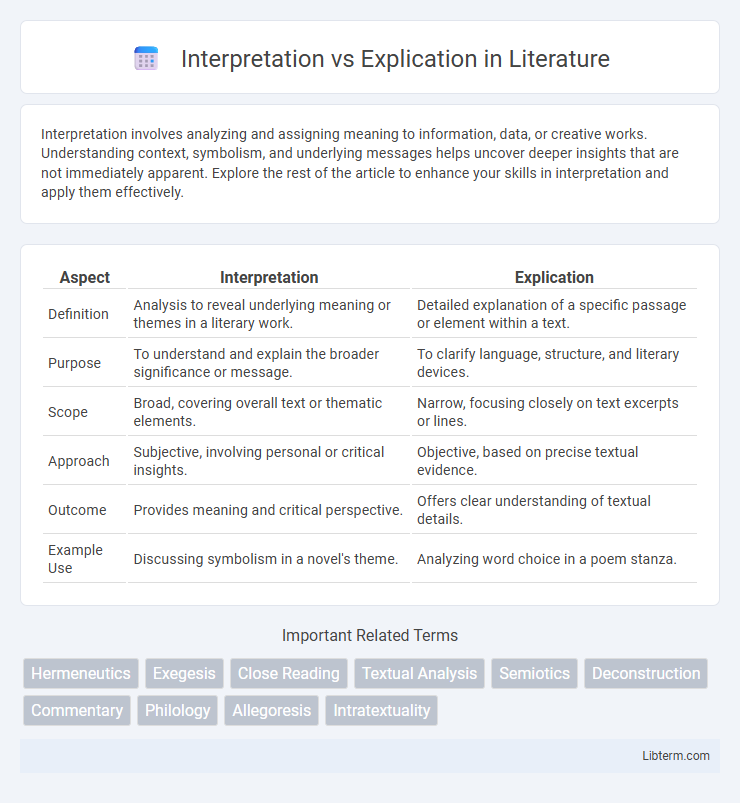Interpretation involves analyzing and assigning meaning to information, data, or creative works. Understanding context, symbolism, and underlying messages helps uncover deeper insights that are not immediately apparent. Explore the rest of the article to enhance your skills in interpretation and apply them effectively.
Table of Comparison
| Aspect | Interpretation | Explication |
|---|---|---|
| Definition | Analysis to reveal underlying meaning or themes in a literary work. | Detailed explanation of a specific passage or element within a text. |
| Purpose | To understand and explain the broader significance or message. | To clarify language, structure, and literary devices. |
| Scope | Broad, covering overall text or thematic elements. | Narrow, focusing closely on text excerpts or lines. |
| Approach | Subjective, involving personal or critical insights. | Objective, based on precise textual evidence. |
| Outcome | Provides meaning and critical perspective. | Offers clear understanding of textual details. |
| Example Use | Discussing symbolism in a novel's theme. | Analyzing word choice in a poem stanza. |
Understanding Interpretation: A Conceptual Overview
Interpretation involves decoding meaning from texts or events by considering context, symbols, and underlying themes to reveal deeper insights. It emphasizes subjective engagement, allowing multiple perspectives to coexist based on cultural, historical, or personal backgrounds. This process contrasts with explication, which systematically analyzes explicit content to clarify structure and meaning without extensive inference.
Defining Explication: Meaning and Scope
Explication involves systematically clarifying the precise meaning of a text or concept by breaking it down into detailed components, enhancing understanding and reducing ambiguity. It employs close analysis and contextual examination to reveal implicit implications and logical structures within the subject matter. This method is particularly valuable in literary criticism, philosophy, and linguistics for deepening comprehension beyond surface interpretation.
Historical Evolution of Interpretation and Explication
The historical evolution of interpretation traces back to ancient hermeneutics, where early scholars aimed to uncover the intended meaning of texts, emphasizing context and tradition. Explication emerged prominently in the 20th century, particularly through the work of Denis Diderot and later formalized by literary theorists who focused on detailed analysis of language and structure within a text. Over time, interpretation expanded towards subjective, thematic understanding, while explication solidified as a method of objective, analytical reading, highlighting their complementary roles in literary criticism.
Key Differences Between Interpretation and Explication
Interpretation involves deriving meaning from a text or phenomenon by analyzing context, symbolism, and underlying themes, whereas explication focuses on a detailed, line-by-line explanation of the text's literal meaning. Key differences lie in interpretation's broader, subjective approach versus explication's objective, analytical method aimed at clarifying content. Interpretation often explores ambiguous or abstract elements, while explication emphasizes precise, explicit understanding of language and structure.
Theoretical Foundations: Interpretation in Philosophy
Interpretation in philosophy centers on uncovering the intended meaning and significance of texts, symbols, or phenomena, emphasizing contextual understanding within hermeneutic traditions. Theoretical foundations draw from phenomenology, structuralism, and post-structuralism to analyze how meaning is constructed, negotiated, and transformed through subjective and intersubjective frameworks. Explication contrasts by focusing on analytical clarification and logical decomposition, aiming to systematically reveal underlying structures rather than exploring dynamic, contextualized meanings.
Methodological Approaches to Explication
Explication employs a systematic methodological approach centered on clarifying ambiguous or complex texts through close reading and detailed analysis of context, language, and structure. It prioritizes breaking down intricate passages into understandable components by examining syntax, semantics, and rhetorical devices to uncover nuanced meanings often overlooked by general interpretation. This method contrasts with broader interpretative practices by emphasizing precision and textual evidence over subjective or thematic speculation.
Interpretation vs Explication in Literary Analysis
Interpretation in literary analysis involves uncovering deeper meanings, themes, and symbolic significance within a text, emphasizing the reader's subjective understanding. Explication, by contrast, focuses on a detailed, objective examination of the text's language, structure, and literary devices to clarify its meaning. While interpretation allows for multiple perspectives, explication aims for precise, text-based explanation and close reading.
Practical Applications in Academic Disciplines
Interpretation involves deriving meaning from texts or phenomena, useful in disciplines such as literature, law, and anthropology to uncover underlying messages or cultural contexts. Explication focuses on systematically analyzing and explaining specific elements, often applied in philosophy, linguistics, and science to clarify concepts and expose detailed structures. Both methods enhance critical thinking and comprehension but serve distinct roles in academic research and pedagogy.
Challenges and Limitations of Each Approach
Interpretation often faces challenges in subjectivity, as individual perspectives can lead to varying conclusions that complicate consensus-building and objective analysis. Explication encounters limitations in its focus on detailed, systematic unpacking of texts, which may overlook broader contextual or emotional nuances critical to understanding. Both approaches struggle with balancing depth and scope, where interpretation risks over-generalization and explication may become overly narrow or technical.
Bridging the Gap: When to Use Interpretation or Explication
Interpretation should be used when uncovering underlying meanings or exploring subjective viewpoints within a text, allowing for broader thematic connections. Explication is suited for detailed, line-by-line analysis where clarity and precise understanding of the text's explicit content are required. Bridging the gap involves assessing the purpose: use explication for exact textual clarity and interpretation to reveal deeper, contextual insights.
Interpretation Infographic

 libterm.com
libterm.com